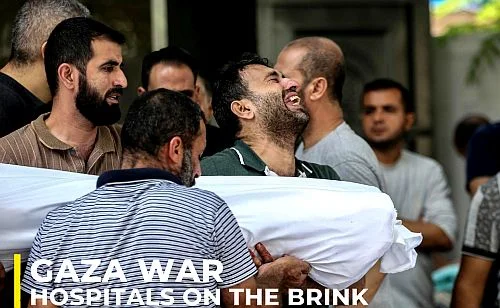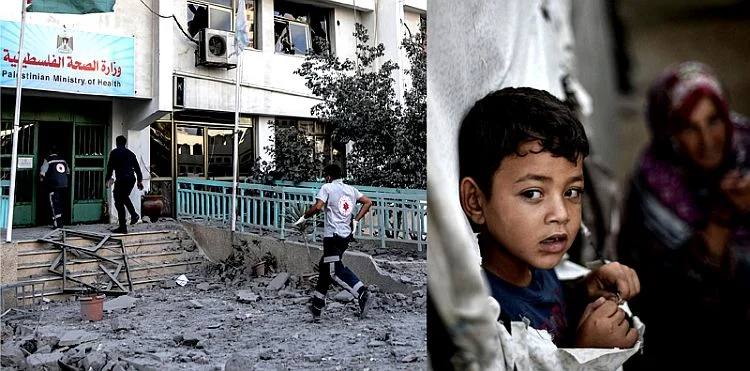Gaza-Egypt border Humanitarian aid is stuck strains hospitals, water supply
RAFAH, Gaza Strip — The healthcare infrastructure in Gaza teetered on the brink of collapse on Monday, with severe water, electricity, and essential medications shortages. Meanwhile, many Palestinians, numbering in the hundreds of thousands, scoured for rapidly diminishing food reserves.
This dire situation unfolded amidst ongoing Israeli airstrikes initiated in response to last week’s tragic events involving Hamas.
Egyptian Foreign Minister Sameh
U.N. officials sounded the alarm, warning thousands of patients’ lives hung in the balance. Mediators were tirelessly working towards brokering a ceasefire that would allow crucial humanitarian aid, currently held up at the Egyptian border, to reach those in desperate need.
Over a week has passed since Israel halted the flow of vital supplies, and attention is now firmly fixed on the Rafah crossing between Gaza and Egypt.
Here, a convoy of aid trucks has been held up for several days, eagerly anticipated by those in need. The closure of the Rafah crossing, Gaza’s sole link to Egypt, was necessitated by Israeli airstrikes conducted last week.
Egyptian Foreign Minister Sameh Shoukry remarked that Israel has yet to express a clear stance regarding granting access. Requests for comments from the Israeli government remained unanswered.
Egyptian Border
Amidst Israel’s preparations for a potential ground incursion into Gaza, which could result in dangerous house-to-house combat, concerns are mounting about the escalation of the conflict.
Israel has already initiated evacuations of communities close to its northern border with Lebanon as a precautionary measure. Meanwhile, Hamas militants in Gaza persist in launching rockets into Israel.
Addressing the Israeli Knesset on Monday, Prime Minister Benjamin Netanyahu delivered a stern message to Iran and Hezbollah, cautioning them against provocation in the northern region.
He emphasized, “Do not challenge us in the north. Do not repeat past mistakes. The consequences you will face today will be significantly more severe.” Netanyahu’s reference pertained to Israel’s conflict with Hezbollah in 2006, an organization operating from Lebanon.
The current conflict has emerged as the most lethal of the five Gaza wars, inflicting significant casualties on both sides. According to the Health Ministry in Gaza, the toll stands at a staggering 2,778 killed and 9,700 wounded.
Meanwhile, over 1,400 individuals in Israel have lost their lives, mostly civilians who fell victim to Hamas’ October 7th attack.
On Monday, the Israeli military reported that at least 199 individuals had been taken as hostages in Gaza, higher than previously estimated. However, it was not clarified whether this figure includes foreign nationals.
The amalgamation of widespread airstrikes causing extensive damage to entire neighborhoods, the depletion of essential supplies, and Israel’s sweeping evacuation directive for the northern region of the Gaza Strip has plunged the densely populated area of 2.3 million residents into a state of turmoil.
Over one million individuals have been forced to abandon their homes, with approximately 60% of them seeking refuge in the roughly 14-kilometer-long (8-mile) zone to the south of the evacuation area, as reported by the United Nations.
Israeli Military
The Israeli military intends to evacuate civilians for safety in preparation for a significant operation against Hamas in the northern part of Gaza.
They contend that militants have established extensive tunnel networks and rocket launchers in this area, much of which is intertwined with residential neighborhoods.
Readmore Hospitals Gaza : warn that thousands could die as supplies run low
However, even as residents from northern Gaza seek refuge in the south, they remain exposed to the threat of airstrikes. In the early hours of Monday, an airstrike targeted a building in Rafah, where three displaced families who had fled Gaza City had taken shelter. Tragically,
this strike lost at least 12 lives, with nine individuals still missing, according to survivors from the al-Masry, al-Akhras, and Hamouda families. The strike left behind a massive crater surrounded by debris.
United Nations Relief and Works Agency
In the southern region, over 400,000 displaced individuals have sought shelter in schools and other facilities managed by the United Nations Relief and Works Agency for Palestine Refugees (UNRWA).
Regrettably, the agency has been unable to provide them with essential aid, forcing them to scavenge for water and food. UNRWA has disclosed that it possesses only one liter of water per day per staff member in Gaza, highlighting the dire shortage.
Gaza City Vicinity
Many displaced people have moved in with relatives, squeezing numerous individuals into crowded homes. With faucets running dry, some have resorted to drinking contaminated or sewage-contaminated water, raising concerns about potential disease outbreaks.
Philippe Lazzarini, the head of UNRWA, expressed deep concern, asserting, “Gaza is running out of water, and Gaza is running out of life.” He urgently called for lifting the siege to address the pressing humanitarian crisis.
The operational bakeries in Gaza are experiencing lengthy queues of people. For instance, Ahmad Salah, who resides in Deir al-Balah, revealed that he waited for a staggering 10 hours to obtain just a kilo (approximately 2 pounds) of bread to provide for his family, which comprises 20 to 30 members.
Shifa Hospital
Israel’s military has, for the third consecutive day, declared the establishment of a secure corridor permitting movement from north to south between 8 a.m. and noon. According to reports, over 600,000 individuals have already evacuated the Gaza City vicinity.
In the northern region of Gaza, the exact number of residents who remain is unknown, as some either cannot or choose not to leave.
When the evacuation order was issued, UNRWA reported that approximately 170,000 people were taking refuge in its schools in the north. However, the agency was unable to facilitate their evacuation and does not possess information on whether they have stayed. Over 40,000 people have congregated in the vicinity of Gaza City’s al-Shifa Hospital and its surrounding streets, hopeful that it will remain safe from bombardment.
Gaza’s Hospitals
UNRWA disclosed on Monday that it had received reports indicating that the Hamas-administered Ministry of Health had removed fuel and medical equipment from its evacuated compound in Gaza City.
Hamas has encouraged residents to disregard the evacuation directive. Israel’s military released photos on Sunday, purportedly showing a Hamas roadblock obstructing southward traffic.
In a concerning development, Gaza’s hospitals are expected to exhaust their generator fuel supply within the next 24 hours, as indicated by the United Nations. Four hospitals in northern Gaza are no longer operational, and 21 have received evacuation orders from Israel. Medical professionals have refused to comply, arguing that it would result in the death of critically ill patients and newborns reliant on ventilators.
Doctors Medical Organization
Doctors Without Borders, a medical aid organization, reported that many of its staff members have chosen to remain in the northern area to provide care to the wounded. However, they have run out of painkillers, and staff members have described hearing “wounded screaming in pain.”
Israel has insisted that the siege on Gaza will not be lifted until Hamas releases all captives. While the country’s water ministry claimed that water service had been restored at a “specific point” in Gaza, located outside the southern town of Khan Younis, aid workers within Gaza have not yet observed concrete evidence of the water’s return.
CNN Report
Israel’s ambassador to the United Nations, Gilad Erdan, conveyed to CNN that Israel has no desire to occupy but is prepared to take necessary actions to eliminate Hamas’ capabilities.
Gaza’s border
With Israeli forces stationed along border and an increasing number of U.S. warships in the region, coupled with the mobilization of approximately 360,000 reservists, preparations have been made for what Israel characterizes as an extensive campaign aimed at dismantling Hamas. Israel asserts that it has already targeted numerous military sites, including command centers and rocket launchers, and has also eliminated Hamas commanders.




